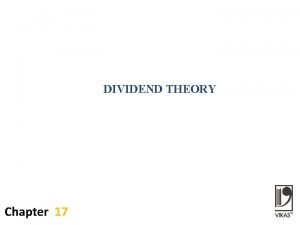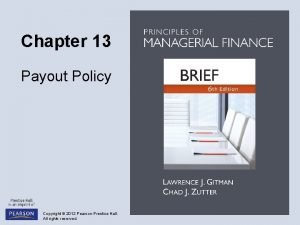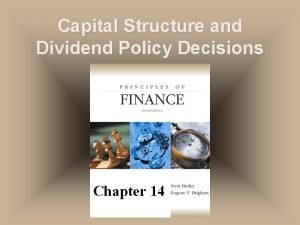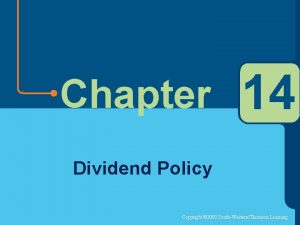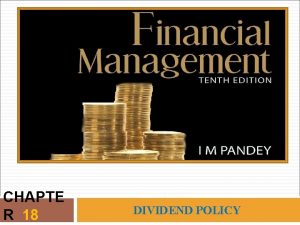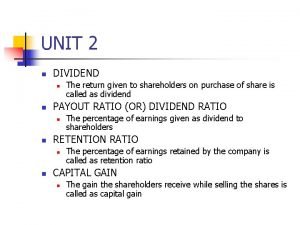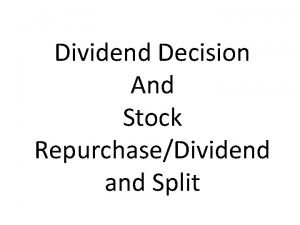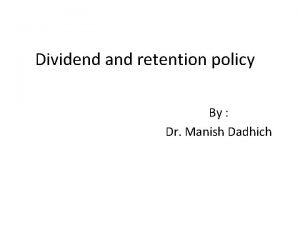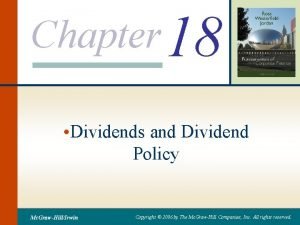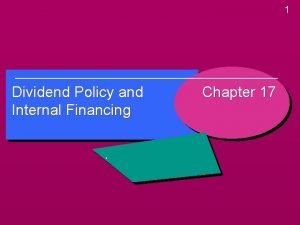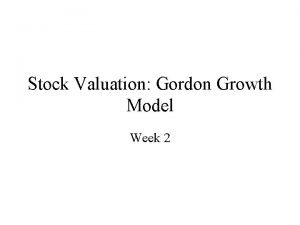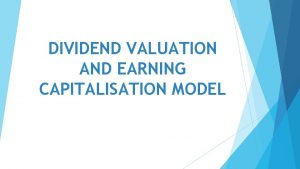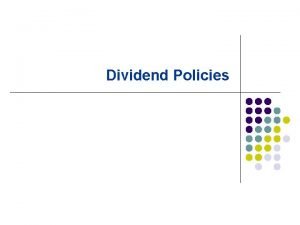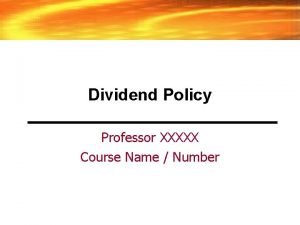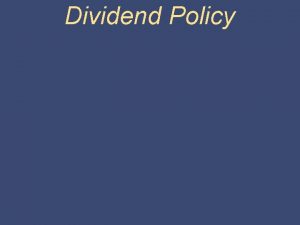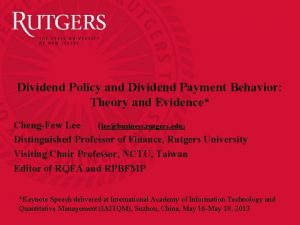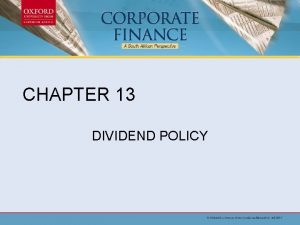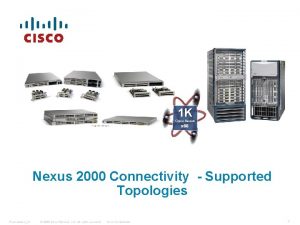DIVIDEND ASSESSMENT THE CASHTRUST NEXUS Dividend policy rests













- Slides: 13

DIVIDEND ASSESSMENT: THE CASHTRUST NEXUS Dividend policy rests on management trust.


The Cash/Trust Assessment Step 1: How much could the company have paid out during the period under question? Step 2: How much did the company actually pay out during the period in question? Step 3: How much do I trust the management of this company with excess cash? How well did they make investments during the period in question? How well has my stock performed during the period in question? 3

How much has the company returned to stockholders? As firms increasing use stock buybacks, we have to measure cash returned to stockholders as not only dividends but also buybacks. For instance, for the companies we are analyzing the cash returned looked as follows. Disney Year 2008 2009 2010 2011 2012 2008 -12 Dividends $648 $653 $756 $1, 076 $1, 324 $4, 457 Vale Buybacks $648 $2, 669 $4, 993 $3, 015 $4, 087 $15, 412 Dividends $2, 993 $2, 771 $3, 037 $9, 062 $6, 006 $23, 869 Buybacks $741 $9 $1, 930 $3, 051 $0 $5, 731 Tata Motors Dividends Buybacks 7, 595₹ 0₹ 3, 496₹ 0₹ 10, 195₹ 0₹ 15, 031₹ 0₹ 15, 088₹ 970₹ 51, 405₹ 970₹ Baidu Dividends ¥ 0 ¥ 0 ¥ 0 Buybacks ¥ 0 ¥ 0 ¥ 0 Deutsche Bank Dividends Buybacks 2, 274 € 0€ 309 € 0€ 465 € 0€ 691 € 0€ 689 € 0€ ¥ 4, 428 ¥ 0 4

A Measure of How Much a Company Could have Afforded to Pay out: FCFE The Free Cashflow to Equity (FCFE) is a measure of how much cash is left in the business after non-equity claimholders (debt and preferred stock) have been paid, and after any reinvestment needed to sustain the firm’s assets and future growth. Net Income + Depreciation & Amortization = Cash flows from Operations to Equity Investors - Preferred Dividends - Capital Expenditures - Working Capital Needs - Principal Repayments + Proceeds from New Debt Issues = Free Cash flow to Equity 5

Disney’s FCFE: 2008 – 2012 2011 2010 2009 2008 $6, 136 $5, 682 $4, 807 $3, 963 $3, 307 $23, 895 - (Cap. Exp - Depr) $604 $1, 797 $1, 718 $397 $122 $4, 638 - ∂ Working Capital ($133) $940 $950 $308 ($109) $1, 956 Free CF to Equity (pre-debt) $5, 665 $2, 945 $2, 139 $3, 258 $3, 294 $17, 301 + Net Debt Issued $1, 881 $4, 246 $2, 743 $1, 190 ($235) $9, 825 = Free CF to Equity (actual debt) $7, 546 $7, 191 $4, 882 $4, 448 $3, 059 $27, 126 Free CF to Equity (target debt ratio) $5, 720 $3, 262 $2, 448 $3, 340 $3, 296 $18, 065 Dividends $1, 324 $1, 076 $756 $653 $648 $4, 457 Dividends + Buybacks $5, 411 $4, 091 $5, 749 $3, 322 $1, 296 Net Income Aggregate $19, 869 Disney returned about $1. 5 billion more than the $18. 1 billion it had available as FCFE with a normalized debt ratio of 11. 58% (its current debt ratio). 6

Estimating FCFE when Leverage is Stable Net Income - (1 - DR) (Capital Expenditures - Depreciation) - (1 - DR) Working Capital Needs = Free Cash flow to Equity DR = Debt/Capital Ratio For this firm, Proceeds from new debt issues = Principal Repayments + d (Capital Expenditures - Depreciation + Working Capital Needs) Thus, whatever debt has to be repaid gets paid off with new debt and additional debt is taken on to fund growth in the firm. 7

An Example: FCFE Calculation Consider the following inputs for Microsoft in 1996. In 1996, Microsoft’s FCFE was: Net Income = $2, 176 Million Capital Expenditures = $494 Million Depreciation = $ 480 Million Increase in Non-Cash Working Capital = $ 35 Million Debt Ratio = 0% FCFE = =$ 2, 176 = Net Income - (Cap ex - Depr) (1 -DR) - Chg WC (!-DR) - (494 - 480) (1 -0) $ 2, 127 Million - $ 35 (1 -0) By this estimation, Microsoft could have paid $ 2, 127 Million in dividends/stock buybacks in 1996. They paid no dividends and bought back no stock. Where will the $2, 127 million show up in Microsoft’s balance sheet? 8

FCFE for a Bank? We redefine reinvestment as investment in regulatory capital. FCFEBank= Net Income – Increase in Regulatory Capital (Book Equity) Consider a bank with $ 10 billion in loans outstanding and book equity of $ 750 million. If it maintains its capital ratio of 7. 5%, intends to grow its loan base by 10% to $11 billion and expects to generate $ 150 million in net income: FCFE = $150 million – (11, 000 -10, 000)* (. 075) = $75 million Deutsche Bank: FCFE estimates (November 2013) Asset Base Capital ratio Tier 1 Capital Change in regulatory capital Book Equity ROE Net Income - Investment in Regulatory Capital FCFE Current 439, 851 € 16. 00% 70, 376 € 76, 829 € -1. 08% -757 € 1 453, 047 € 16. 00% 72, 487 € 2, 111 € 78, 940 € 2 466, 638 € 16. 00% 74, 662 € 2, 175 € 81, 115 € 3 480, 637 € 16. 00% 76, 902 € 2, 240 € 83, 355 € 4 495, 056 € 16. 00% 79, 209 € 2, 307 € 85, 662 € 5 509, 908 € 16. 00% 81, 585 € 2, 376 € 88, 038 € 0. 74% 584 € 2, 111 € -1, 528 € 2. 55% 2, 072 € 2, 175 € -102 € 4. 37% 3, 642 € 2, 240 € 1, 403 € 6. 18% 5, 298 € 2, 307 € 2, 991 € 8. 00% 7, 043 € 2, 376 € 4, 667 € 9

Dividends versus FCFE: Across the globe Dividend Class Emerging Aus, NZ & Markets Canada US Europe Japan Global FCFE<0, No Dividends/Buybacks 28. 31% 28. 38% 10. 90% 21. 78% 59. 49% 26. 91% FCFE >0, No Dividends/Buybacks FCFE >0, FCFE>Dividends+Buybacks 29. 86% 19. 56% 13. 26% 23. 01% 15. 76% 22. 05% 14. 52% 22. 93% 35. 04% 22. 98% 9. 02% 21. 10% CASH ACCUMULATORS FCFE >0, FCFE<Dividends+Buybacks 44. 38% 42. 49% 48. 30% 45. 98% 24. 77% 43. 16% 8. 80% 9. 74% 8. 40% 7. 91% 4. 62% 8. 05% FCFE<0, 've Dividends+Buybacks 18. 51% 19. 38% 32. 40% 24. 34% 11. 11% 21. 88% OVER PAYERS 27. 31% 29. 12% 40. 80% 32. 24% 15. 73% 29. 93% 10

The Consequences of Failing to pay FCFE 11

6 Application Test: Estimating your firm’s FCFE In General, Net Income + Depreciation & Amortization - Capital Expenditures - Change in Non-Cash Working Capital - Preferred Dividend - Principal Repaid + New Debt Issued = FCFE Compare to Dividends (Common) + Stock Buybacks If cash flow statement used Net Income + Depreciation & Amortization + Capital Expenditures + Changes in Non-cash WC + Preferred Dividend + Increase in LT Borrowing + Decrease in LT Borrowing + Change in ST Borrowing = FCFE B FA page PB Page 44 12

Task Estimate the potential dividends for your company and it’s current cash balance. 13 Read Chapter 11
 Gordon model formula for dividend policy
Gordon model formula for dividend policy Dividend declaration date
Dividend declaration date Factors affecting dividend policy
Factors affecting dividend policy Types of dividend policy
Types of dividend policy Dividend policy and capital structure
Dividend policy and capital structure The residual theory of dividend policy asserts that
The residual theory of dividend policy asserts that Objectives of dividend policy
Objectives of dividend policy Payout ratio formula
Payout ratio formula Stock split formula
Stock split formula Walter theory
Walter theory The information content of dividends refers to
The information content of dividends refers to Compromise dividend policy
Compromise dividend policy Alternative dividend policies
Alternative dividend policies Gordon model example
Gordon model example
